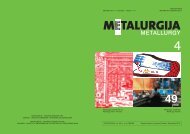Synthesis and potential biological activity of some novel 3-[(N ...
Synthesis and potential biological activity of some novel 3-[(N ...
Synthesis and potential biological activity of some novel 3-[(N ...
Create successful ePaper yourself
Turn your PDF publications into a flip-book with our unique Google optimized e-Paper software.
A. H. M<strong>and</strong>our et al.: <strong>Synthesis</strong> <strong>and</strong> <strong>potential</strong> <strong>biological</strong> <strong>activity</strong> <strong>of</strong> <strong>some</strong> <strong>novel</strong> 3-[(N-substituted indol-3-yl)methyleneamino]-6-amino-4aryl-pyrano(2,3-c)pyrazole-5-carbonitriles<br />
<strong>and</strong> 3,6-diamino-4-(N-substituted indol-3-yl)pyrano(2,3-c)pyrazole-5-carbonitriles, Acta Pharm.<br />
62 (2012) 15–30.<br />
CH2(CN) 2<br />
E EtOH,<br />
Et3N 1–7 R<br />
a H<br />
b -CH2CH3 the following protocol: one group received 2%Tween 80 (solvent negative control), the<br />
second group received flufenamic acid as reference (20 mg kg –1 ), the third group received<br />
indomethacine as reference (5 mg kg –1 ), while the other groups received two doses<br />
<strong>of</strong> test compounds (20 <strong>and</strong> 5 mg kg –1 ). One hour latter, a 0.02 % solution <strong>of</strong> p-benzoquinone<br />
was administered (i.p.). The animals were observed for 30 minutes after injection<br />
<strong>of</strong> the irritant, during which time the animals showing writhing were counted (writhing<br />
is defined as stretching, torsion to one side, drawing up <strong>of</strong> hind leg, retraction <strong>of</strong><br />
the abdomen, so that the mouse belly touches the floor). All writhing is considered as a<br />
positive response. The analgesic <strong>activity</strong> was expressed as percent protection.<br />
Anticonvulsant <strong>activity</strong>. – The electric shock seizure test (19) was taken as the criterion<br />
for the evaluation <strong>of</strong> anticonvulsant <strong>activity</strong>. Mice were injected intraperitoneally<br />
with2%Tween 80 (solvent, negative control) <strong>and</strong> 5 mg kg –1 diazepam (reference drug).<br />
The other groups received two doses (25 <strong>and</strong> 12.5 mg kg –1 ) <strong>of</strong> each test compound. One<br />
hour after drug administration, animals were stimulated through an ear electrode <strong>of</strong> 50<br />
mA as a signal stimulator for 0.2 s. The characteristic <strong>of</strong> electric shock seizure is a tonic<br />
limb flexion <strong>of</strong> 1 to 2 s, followed by a tonic limb extension <strong>of</strong> roughly 10 to 12 s, <strong>and</strong> finally<br />
generalized clonic movement for 12 s. Only abolishment <strong>of</strong> the hind limb tonic<br />
extensor spasm is recorded as the measure <strong>of</strong> anticonvulsant potency. The tonic component<br />
is considered abolished if the hind leg extension does not exceed a 90° angle with<br />
the plane <strong>of</strong> the body. Animals showing protection against convulsion were counted in<br />
each group. The anticonvulsant <strong>activity</strong> was expressed as percent protection.<br />
22<br />
c -COC6H5 d -COC6H4Cl-p e -COC6H4Cl-o f -SO 2 C 6 H 5<br />
g -SO 2 C 6 H 4 Br-p<br />
N<br />
R<br />
1<br />
N<br />
R<br />
5<br />
CHO<br />
CH<br />
H 2N<br />
C(CN) 2<br />
N NH<br />
O<br />
EtOH, Et 3N, reflux<br />
H 2N<br />
EtOH, Et 3N, reflux<br />
Scheme 2<br />
N NH<br />
Method B<br />
O<br />
H 2N<br />
N<br />
CH<br />
R<br />
N<br />
N<br />
R<br />
O<br />
N<br />
7<br />
6<br />
NH<br />
N<br />
NH 2<br />
CH2(CN) 2<br />
EtOH, Et3N, reflux<br />
Method A<br />
O<br />
CN<br />
NH 2

















